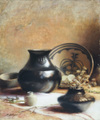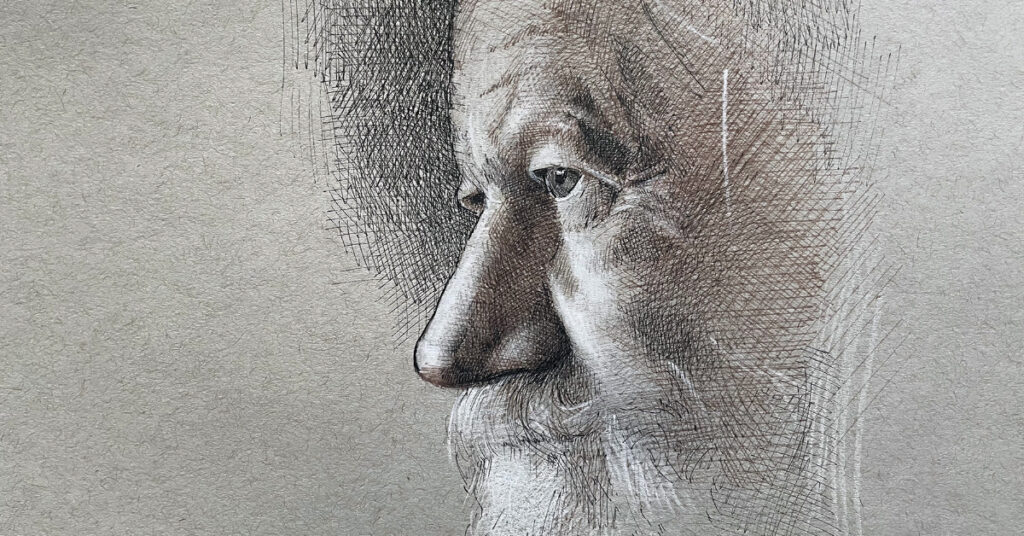Beginner Oil: How to set up a Still Life

 Arranging the objects in a still life painting can be as challenging—and enjoyable—as painting the subject matter. Here we offer advice from several still life painters on how to create a visually stimulating setup.
Arranging the objects in a still life painting can be as challenging—and enjoyable—as painting the subject matter. Here we offer advice from several still life painters on how to create a visually stimulating setup.
 |
| Blackware, Papaya, and Melon, by Ellen Buselli, 2007, oil on linen, 10 x 14. All artwork this article private collection. |
by Naomi Ekperigin
Although most still life painters follow the same steps when creating a painting–they select subjects, arrange and light them in a specific way, and then use this setup as inspiration for a work of art—there are infinite possibilities when it comes from arrangement. “Artists of the past often spent a great deal of time arranging their objects and inventing ways to secure them in desired positions,” says artist Christopher Willard. “One goal in setting up a still life is to become excited by what you see. You can assemble objects into an extravagant arrangement, but it’s not a requirement for a good still life. It’s quite possible for an artist to paint a single cup over and over again and create an interesting body of work. It’s not so much the objects themselves but how you use them in your painting that’s important.”
Many artists spend a majority of their time looking at their subject, studying it from various angles or taking photographs to find the point of view that best captures the mood they wish to express. Says painter William C. Collins, “The visual experience is the key to finding the structure of the painting,” he says. “I set up objects in a still life in response to my seeing. It’s a process of moving things around until I get what I call an ‘Ah-ha’ experience. It’s the feeling that the objects I’ve chosen fit together in a meaningful way.” Artist Raenell Doyle echoes this sentiment. “When I know a flower I want to paint is coming into bloom, I start thinking about how to arrange a composition that will best express its beauty,” she says. “If the flower is the main character in this staged arrangement, the rest of the setup must complement and support it. Sometimes it takes a lot of arranging and rearranging.” Only by viewing her setup from all possible vantage points can Doyle determine the composition that best highlights her center of interest.
 |
| A Place in the Corner, by Guido Frick, 2007, oil, 30 x 24. |
Painter Ellen Buselli, who paints a variety of subject matter, finds that her still lifes are all united by a common interest. “My favorite subject matter is really light and shadow, as well as shape, mass, color, and texture,” she says. “Over the years I’ve collected many artifacts and I enjoy painting them all. But, in truth, a simple setup is just as interesting to paint as a more complicated piece with beautiful objects. That’s because an artist isn’t painting the objects, but is painting how the light, shadow and transitions create a pleasing image.” Because Buselli focuses on light and shadow, establishing a light source is her first concern when setting up a still life. “It’s not just the objects that you should be considering for the composition,” she advises, “but all the elements that are created by juxtaposing objects together on a lit plane.” Most still life painters prefer to paint under a natural, north light, because it’s cooler, and shadows remain relatively constant throughout a day of painting. With a sense of continuity, one can focus on the subject and not rush to keep up with fast-moving light.
Artist-instructor Guido Frick, who primarily paints landscapes and still lifes, starts each of his workshops with a still life set up outdoors. “Judging the right temperatures, values, and colors are much easier to do with a still life than a landscape painting,” he explains. “Painting a still life outdoors helps one become familiar with outdoor conditions and learn how colors are affected by the atmosphere. The bright red of the apple is still bright enough on the table, but the colors already have an atmospheric touch. In natural light it is also easier for a beginning artist to see that shadows are not simply black, but colorful.” Frick usually sets up the still life for his beginner classes, but follows general rules when creating his setup that he shares with more advanced students. “Don’t put too many items on the table,” he advises. “Find the right balance between almost empty and overloaded. Thirty to 40 percent of the composition should be empty space. It’s also important to create harmonies—put objects together that work well together. For example, it is not harmonious to paint a beautiful bouquet of flowers in a vase and have on the table next to it a half-full ashtray.
 |
| Blackware, by Ellen Buselli, 2004, çoil on linen, 18 x 15. |
 |
| Mixed Lilacs, by Guido Frick, 2008, oil, 30 x 30. |
“It’s also important to create an interesting rhythm,” he continues. “Before you begin painting, look at your setup and follow the outline of your entire still life. Is it just straight across, with no curves, angles, or high and low planes? If so, it will result in a boring, static image. Avoid this by choosing subjects with different widths, heights, and volumes.” Frick also suggests that, once the setup is complete, artists paint at a distance of no more than two or three yards away from the subject. If you are right-handed, you should place your still life on your left, so that your arm does not block your view (and vice versa for left-handed painters).
For many artists, the infinite possibilities within still life paintings are what add to the enjoyment of the genre. Though there are several techniques one can employ to create a visually stimulating painting, there is no right way to setup a still life. Choosing subject matter that is appealing and meaningful will ultimately make the painting process more enjoyable, regardless of whether you adhere strictly to each rule. Finding the process most suitable to one’s needs requires patience and a willingness to try techniques that are both tried-and-true and experimental.





Have a technical question?
Contact UsJoin the Conversation!